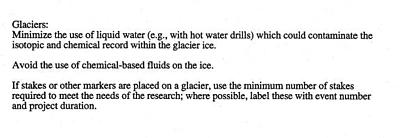26 October, 1999
I'd like to devote today's journal to what I will be doing in the Dry
Valleys. (Materials below taken from 1999 -2000 Science Planning Summary
of the Unites States Antarctic Program)
McMurdo Dry Valleys: A Cold Desert Ecosystem Long-Term Ecological Research
(LTER)
Dr. W. Berry Lyons, Project manager
University of Alabama
The McMurdo Dry Valleys are located on the western coast of McMurdo Sound
and form the largest ice free area in Antarctic. In 1993 this area became
part of the National Science Foundation's Long Term Ecological Research
program (LTER) as a representative of one of the coldest and most extreme
deserts in the world.
The living things found in the Dry Valleys consist only of microbes,
microinvertebrates (nematodes), mosses and lichens. Nevertheless, there
are complex relationships and cycles that exist in the soil, lakes and
streams of the Dry Valleys. Sunlight during the austral summer causes
some glacial melting. This melt water is responsible to a large degree
for replenishing the water and nutrients of this ecosystem. This
parcticular ecosystem is influenced greatly by climate and material
transport.
The overall objective of the LTER project of the Dry Valleys is to
understand the influence of physical and biological constraints and the
structure and function of this parcticular ecosystem. These objectives will
be accomplished through a program of systematic environmental data
collection, long tem experiments and model development. (Use the
scientific method to gather information, form conclusions and then build a
model. Remember models do two things: account for observable facts and
then enable you to make predictions. (Think of a sealed can that you
shake and hear sloshing. The observed fact is the sloshing, the model is
that there is a partially liquid filled space, the prediction would be if
I froze this, the sloshing would stop.) This same concept of model
building will be applied to the biological and physical (temperature, wind,
topography, etc) observations that are made and from this predictions will
be made.)
The McMurdo LTER project will emphasize the integration of the biological
processes within and material transport betweens, streams, lakes, and the
terrestrial ecosystems in the dry valleys.
The specific investigations of this years field work are as follows:
Evaluate lake dynamics using Helium isotopes
(Same atomic number different atomic mass)
Look at the carbon and nitrogen isotope signatures in the
lakes (How, where and how much of these
materials are found in these lakes.
Determine the hydrologic balance
Evaluate the role of wind as a link amongst streams, lakes and
soils
Look at the chemistry of the meltwater streams on the glacial surface
This is the overall plan for all this years field work. My work is
specifically known as BM-042-L: Chemistry of streams, lakes and glaciers.
We will be monitoring the inorganic chemistry of water collected from
streams, glaciers and lakes of the Dry Valleys. We will work out of Lake
Hoare, Lake Fryxell and Lake Bonney field camps. Rocks and water samples
will be collected for helium analysis to provide data on the age of
glacial deposits, on the water budget and the age of the lakes. We will
travel by helicopter throughout the area gathering samples. The goal is to
characterize the dissolved and suspended load (materials) in the streams.
As I understand it most of my work will be at the Lake Hoare site.

Contact the TEA in the field at
.
If you cannot connect through your browser, copy the
TEA's e-mail address in the "To:" line of
your favorite e-mail package.
|
